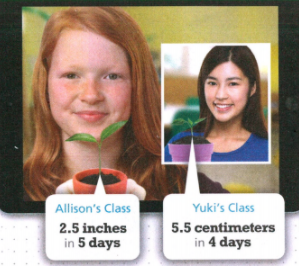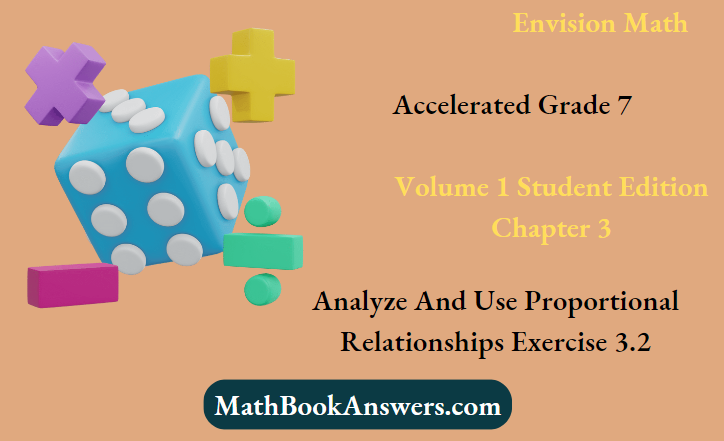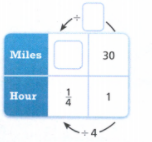Envision Math Accelerated Grade 7 Volume 1 Chapter 3 Analyze And Use Proportional Relationships
Question. Allison and her classmates planted bean seeds at the same time as Yuki and her classmates in Tokyo did. Determine who should expect to have the taller plant at the end of the school year.
Given:
Allison and her classmates planted bean seeds at the same time as Yuki and her classmates in Tokyo did.
Allison is video-chatting with Yuki about their class seedlings Assume that both plants will continue to grow at the same rate.
We need to determine who should expect to have the taller plant at the end of the school year.

The rate of growth of Allison Class’s bean seeds will be
\(\frac{\text { Number of inches }}{\text { Number of days }}\)=\(\frac{2.5}{5}\)
= 0.5 inches per day
Converting inches to the centimeter, we know that, 1 inch=2.54 centimeters
Thus, 0.5 inches = \(\frac{2.54}{2}\)
= 1.27 centimeter
The rate of growth of Yuki Class’s bean seeds will be,
\(\frac{\text { Number of centimeters }}{\text { Number of days }}\)=\(\frac{5.5}{4}\)
= 1.375 centimeters per day
Therefore, Yuki Class’s bean seeds grow taller per day.
Yuki’s class is expected to have the taller plant at the end of the school year.

Envision Math Accelerated Grade 7 Chapter 3 Exercise 3.2 Answer Key
Question. Explain how we can compare the growth rates of the seedlings.
We need to explain how we can compare the growth rates of the seedlings.
We need to determine the unit rate of each to determine which one will be tallest at the end of the year.
Since both plants will continue to grow at the same rate.
The rate of growth of Allison Class’s bean seeds will be 1.27 centimeters per day.
The rate of growth of Yuki Class’s bean seeds will be 1.375 centimeters per day.
Thus, the rate of growth or the unit rate determines the growth rates of both the seedlings.
This will help us to compare their growth.
The rate of growth or the unit rate helps us compare the growth rates of the seedlings.
Question. Explain what the students must have done before they can compare the heights of the plants.
We need to explain what the students must have done before they can compare the heights of the plants.
We need to determine the unit rate of each to determine which one will be tallest at the end of the year.
Since both plants will continue to grow at the same rate. The rate of growth of Allison Class’s bean seeds will be 1.27 centimeters per day.
The rate of growth of Yuki Class’s bean seeds will be 1.375 centimeters per day.
Thus, the rate of growth or the unit rate determines the growth rates of both the seedlings.
This will help us to compare their growth.
The students must have done finding out the rate of growth of both the seedlings before they can compare the heights of the plants.
Question. Sergio increases his target speed to 30 miles per hour. Determine how many more miles does Sergio need to ride in \(\frac{3}{4}\) hour to achieve this target speed.
Given:
Sergio increases his target speed to 30 miles per hour.
We need to determine how many more miles does Sergio need to ride in
\(\frac{3}{4}\)hour to achieve this target speed.

Forming an equation using the proportional relationship given, we get
\(\frac{\frac{1}{4}}{1}=\frac{x}{30}\) \(\frac{1}{4}=\frac{x}{30}\)\(\frac{30}{4}\)=x
x = 7.5
Therefore, Sergio rode 7.5 miles in \(\frac{1}{4}\)hour.
Thus, Sergio needs to ride 30−7.5 = 22.5 miles in \(\frac{3}{4}\) hour to achieve this target speed.
Sergio must ride 7.5 miles in \(\frac{1}{4}\)hour to achieve this target speed, so he needs to ride an additional 22.5 miles per \(\frac{3}{4}\) hour.
Question. Bronwyn’s brother Daniel mows the lawn. He can mow 15,000 ft in \(\frac{3}{4}\) hour. Who mows the lawn in less time?
Given:
Every other weekend, Bronwyn’s brother Daniel mows the lawn. He can mow 15,000 ft in \(\frac{3}{4}\) hour.
To find/solve
Who mows the lawn in less time?
\(\frac{15000}{\frac{3}{4}}\) \(\frac{15000 \div \frac{3}{4}}{\frac{3}{4} \div \frac{3}{4}}=\frac{15000 \cdot \frac{4}{3}}{\frac{3}{4} \cdot \frac{4}{3}}=\frac{20000}{1}\)He mows more in less time, so he will finish faster than Bronwyn.
Envision Math Grade 7 Chapter 3 Proportional Relationships Exercise 3.2 Solutions
Question. Explain how does the unit rate describe Sergio’s cycling speed and how is the unit rate helpful in determining how much.
We need to explain how does the unit rate describe Sergio’s cycling speed and how is the unit rate helpful in determining how much.
Farther Sergio must cycle in a given amount of time each time he increases his target speed.
The unit rate helps in determining how many miles he travels per hour based on Sergio’s cycling speed.
The unit rate here is the rate of change in the number of miles every hour.
From the given information
\(\frac{\frac{1}{4}}{1}=\frac{x}{30}\) \(\frac{1}{4}=\frac{x}{30}\)\(\frac{30}{4}\)=x
x=7.5 miles
This is for the target speed of 30 miles he needs to ride 7.5 miles in 15 minutes.
The unit rate describes Sergio’s cycling speed by determining the number of miles he can travel every hour. The unit rate is helpful in determining how much farther Sergio must cycle in a given amount of time each time he increases his target speed.
Question. Jacob mixes \(\frac{1}{3}\) cup of yellow paint for every \(\frac{1}{5}\) cup of blue paint to make green paint. How many cups of yellow paint are needed for 1 cup of blue paint?
Given:
Jacob mixes \(\frac{1}{3}\) cup of yellow paint for every
\(\frac{1}{5}\) cup of blue paint to make green paint
To find/solve
How many cups of yellow paint are needed for 1 cup of blue paint?
First, we should find unit rate by dividing both by the denominator.
\(\frac{\frac{1}{3}}{\frac{1}{5}}=\frac{\frac{1}{3} \div \frac{1}{5}}{\frac{1}{5} \div \frac{1}{5}}=\frac{\frac{1}{3} \cdot \frac{1}{5}}{\frac{1}{5} \cdot \frac{5}{1}}=\frac{5}{3}\)
\(\frac{5}{3}\) Cups of yellow paint.
Question. Explain how is making a table of equivalent ratios to find the unit rate similar to finding the unit rate by calculating with fractions.
We need to explain how is making a table of equivalent ratios to find the unit rate similar to finding the unit rate by calculating with fractions.
For example, let the fraction be \(\frac{2}{3}\)
Making the table of equivalent ratios, we get.
Multiply both the numerator and the denominator by the same number, and we get

Therefore, the ratios \(\frac{2}{3}, \frac{4}{6}, \frac{6}{9}, \frac{8}{12}, \frac{10}{15}\) are equivalent to each other.
The unit rate of the same by using the fractions are given as
\(\frac{8}{12}\) =\(\frac{4}{6}\)
=\(\frac{2}{3}\)
We can easily see what the terms, with equivalent ratios are.
Both the unit rates and the equivalent ratios are the same.
Equivalent ratios will have the same value when simplified. Equivalent rates can be found similar to the equivalent ratios by performing the same multiplication or the division on both the numerator and the denominator.
Question. Brad buys two packages of mushrooms. Which mushrooms cost less per pound?
Given:
Brad buys two packages of mushrooms.
To find/solve
Which mushrooms cost less per pound?
First, we should find the unit rate by dividing both by the denominator. Cremini:
\(\frac{11.25}{\frac{2}{3}}=\frac{11.25 \div \frac{2}{3}}{\frac{2}{3} \div \frac{2}{3}}=\frac{11.25 \cdot \frac{3}{2}}{\frac{2}{3} \cdot \frac{3}{2}}=\frac{16.8}{1}\)Chanterelle:
\(\frac{7.99}{\frac{1}{2}}=\frac{7.99 \div \frac{1}{2}}{\frac{1}{2} \div \frac{1}{2}}=\frac{7.99 \cdot \frac{1}{2}}{\frac{1}{2} \cdot \frac{2}{1}}=\frac{15.98}{1}\)Chanterelle mushrooms cost less per pound.
Analyze And Use Proportional Relationships Grade 7 Exercise 3.2 Envision Math
Question. The recipe calls for \(1 \frac{1}{4}\) cups of flour and \(\frac{1}{2}\). How many cups of flour will Jed need if he uses 3 sticks of butter?
Given:
The recipe calls for \(1 \frac{1}{4}\)cups of flour and
\(\frac{1}{2}\)To find/solve
How many cups of flour will Jed need if he uses 3 sticks of butter?
First we should find unit rate by dividing both by denominator.
\(\frac{1 \frac{1}{4}}{\frac{1}{2}}=\frac{\frac{5}{4} \div \frac{1}{2}}{\frac{1}{2} \div \frac{1}{2}}=\frac{5}{2}\)Now we have to find equivalent ration that shows us how much flour is needed per 3 sticks of butter.
\(\frac{\frac{5}{2} \cdot 3}{1.3}=\frac{\frac{15}{2}}{3}=\frac{7.5}{3}\)7.5 per 3
7.5 per 3 cups of flour will Jed need if he uses 3 sticks of butter.
Question. Find unit rate by dividing both by denominator Miles \(\frac{3}{5}\) and Hours \(\frac{1}{3}\)
Given:
Miles \(\frac{3}{5}\)
Hours \(\frac{1}{3}\)
To find/solve
First we should find unit rate by dividing both by denominator.
\(\frac{\frac{3}{5}}{\frac{1}{3}}=\frac{\frac{3}{5} \div \frac{1}{3}}{\frac{1}{3} \div \frac{1}{3}}=\frac{\frac{3}{5} \cdot \frac{3}{1}}{\frac{1}{3} \cdot \frac{3}{1}}=\frac{9}{5}=\frac{1.8}{1}\)
1.8 per 1.
Question. \(\frac{7 \mathrm{mi}}{\frac{1}{3} \mathrm{gal}}\) find unit rate by dividing both by denominator.
Given:
\(\frac{7 \mathrm{mi}}{\frac{1}{3} \mathrm{gal}}\)To find/solve.
First we should find unit rate by dividing both by denominator.
\(\frac{7}{\frac{1}{3}}=\frac{7 \div \frac{1}{3}}{\frac{1}{3} \div \frac{1}{3}}=\frac{7 \cdot \frac{3}{1}}{\frac{1}{3} \cdot \frac{3}{1}}=\frac{21}{1}\)
\(\frac{7 \mathrm{mi}}{\frac{1}{3} \mathrm{gal}}\)=\(\frac{21}{1}\)
Question. Find unit rate by dividing both by denominator \(\frac{\frac{3}{4}\text{ page }}{2 \text { minutes}}\)
Given:
\(\frac{\frac{3}{4} \text { page }}{2 \text { minutes }}\)
To find/solve
Page in 1 minute.
First we should find unit rate by dividing both by denominator.
\(\frac{\frac{3}{4}}{2}=\frac{\frac{3}{4} \div 2}{2 \div 2}=\frac{3}{8}\)
\(\frac{3}{8}\) per 1
\(\frac{3}{8}\) per 1
Question. Hadley paddled a Canoe \(\frac{2}{4}\) mile in \(\frac{1}{4}\). How fast did Hadley paddle, in miles per hour?
Given:
Hadley paddled a Canoe\(\frac{2}{4}\) mile in \(\frac{1}{4}\)
To find/solve
How fast did Hadley paddle, in miles per hour?
First we should find unit rate by dividing both by denominator.
\(\frac{\frac{2}{3}}{\frac{1}{4}}=\frac{\frac{2}{3} \div \frac{1}{4}}{\frac{1}{4} \div \frac{1}{4}}==\frac{\frac{2}{3} \cdot \frac{4}{1}}{\frac{1}{4} \cdot \frac{4}{1}}=\frac{8}{3}\)
\(\frac{2}{4}\) per 1.
Hadley paddle, in miles per hour \(\frac{2}{4}\) per 1.
Question. A box of cereal states that there are 90 calories in a \(\frac{3}{4}\) cup serving. How many Calories are there in 4 cups of cereal?
Given:
A box of cereal states that there are 90 calories in a \(\frac{3}{4}\) cup serving
To find/solve
How many Calories are there in 4 cups of cereal?
First we should find unit rate by dividing both by denominator.
\(\frac{90}{\frac{3}{4}}=\frac{90 \div \frac{3}{4}}{\frac{3}{4} \div \frac{3}{4}}=\frac{90 \cdot \frac{4}{3}}{\frac{3}{4} \cdot \frac{4}{3}}=\frac{120}{1}\)Now we just have to find equivalent ratio that will show the amount per 4.
\(\frac{120.4}{1.4}=\frac{480}{4}\)
480 per 4 Calories are there in 4 cups of cereal.
Question. A robot can complete 8 tasks in \(\frac{5}{6}\) hour. How long does it take the robot to complete one task?
Given:
A robot can complete 8 tasks in \(\frac{5}{6}\) hour
To find/solve
How long does it take the robot to complete one task?
We have to find the unit rate that will show us the ratio of fractions.
\(\frac{\frac{5}{6}}{8}=\frac{\frac{5}{6} \div 8}{8 \div 8}=\frac{\frac{5}{48}}{1}=\frac{5}{48}\)
\(\frac{5}{48}\) per task
\(\frac{5}{48}\) per task take the robot to complete one task.
Given:
A robot can complete 8 tasks in \(\frac{5}{6}\) hour. Each task takes the same amount of time.
To find/solve
How many tasks can the robot complete in one hour?
We have to find unit rate that will show us the ratio of fraction.
\(\frac{\frac{8}{5}}{6}=\frac{8 \div \frac{5}{6}}{\frac{5}{6} \div \frac{5}{6}}=\frac{8 \cdot \frac{6}{5}}{\frac{5}{6} \cdot \frac{6}{5}}=\frac{\frac{48}{5}}{1}=\frac{48}{5}\) \(\frac{48}{5}=9 \frac{3}{5} \text { per } 1\)\(\frac{48}{5}=9 \frac{3}{5} \text { per } 1\) tasks can the robot complete in one hour.
Envision Math Grade 7 Exercise 3.2 Solution Guide
Question. Find out which car can travel a greater distance on 1 gallon of gas.
Given:
You want to find out which car can travel a greater distance on 1 gallon of gas.
To find/solve
What is the gas mileage, in miles per gallon, for the blue car?
The ratio of miles per gallon
We have to divide both terms by the denominator term.
\(\frac{35 \frac{1}{2}}{1 \frac{1}{2}}=\frac{\frac{71}{2}}{\frac{3}{2}}=\frac{\frac{71}{2} \div \frac{3}{2}}{\frac{3}{2} \div \frac{3}{2}}=\frac{\frac{71}{2} \cdot \frac{2}{3}}{\frac{3}{2} \cdot \frac{2}{3}}=\frac{\frac{71}{3}}{1}=\frac{71}{3}\) \(\frac{71^{-}}{3}=23 \frac{2}{3} \text { per } 1\)
The gas mileage is \(\frac{71}{3}=23 \frac{2}{3} \text { per } 1\) in miles per gallon, for the blue car.
Given:
You want to find out which car can travel a greater distance on 1 gallon of gas.
To find/solve
What is the gas mileage, in miles per gallon, for the silver car?
The ratio of miles per gallon
We have to divide both terms by the denominator term.
\(\frac{27 \frac{1}{5}}{\frac{4}{5}}=\frac{\frac{136}{5} \div \frac{4}{5}}{\frac{4}{5} \div \frac{4}{5}}=\frac{\frac{136}{5} \cdot \frac{4}{5}}{\frac{4}{5} \cdot \frac{5}{4}}=\frac{34}{1}\)34 per 1.
34 per 1 is the gas mileage, in miles per gallon, for the silver car.
Given:
You are running a fuel economy study. You want to find out which car can travel a greater distance on 1 gallon of gas.
To find/solve
Which car could travel the greater distance on 1 gallon of gas?
Blue car
\(\frac{23 \frac{2}{3}}{1}\)Silver car
\(\frac{34}{1}\) \(23 \frac{2}{3}<34\)
Silver car travel a greater distance on 1 gallon of gas.
Silver car travel a greater distance on 1 gallon of gas.
Question. \(\text { Henry incorrectly said the rate } \frac{\frac{1}{5} \text { pound }}{\frac{1}{20} \text { quart }}\) can be written as the unit rate \(\) pound per quart. Find the unit rate we have to divide both terms by the denominator.
Given:
\(\text { Henry incorrectly said the rate } \frac{\frac{1}{5} \text { pound }}{\frac{1}{20} \text { quart }}\) can be written as the unit rate \(\) pound per quart.
To find/solve
What is the correct unit rate?
To find unit rate we have to divide both terms by the denominator.

4 per 1 is the correct unit rate.
Given:
\(\text { Henry incorrectly said the rate } \frac{\frac{1}{5} \text { pound }}{\frac{1}{20} \text { quart }}\) can be written as the unit rate \(\) pound per quart.
To find/solve
What error did Henry likely make?
Ratios with fractions.
Convert the fractions so they have a common denominator, and multiply both fractions by the common denominator.
Simplify by dividing by the highest common factor.
He probably didn’t divide both terms by denominator.
He didn’t follow rules for finding unit rates.
He didn’t follow rules for finding unit rates.
Envision Math Accelerated Grade 7 Chapter 3 Exercise 3.2 Answers
Question. Ari walked \(2 \frac{3}{4}\) miles at a constant speed of \(2 \frac{1}{2}\)miles per hour. Beth walked \(1 \frac{3}{4}\)miles at a constant speed of \(1 \frac{1}{4}\) miles per hour. Cindy walked for 1 hour and 21 minutes at a constant speed of \(1 \frac{1}{8}\) miles per hour.
Given:
Ari walked \(2 \frac{3}{4}\) miles at a constant speed of \(2 \frac{1}{2}\)miles per hour. Beth walked \(1 \frac{3}{4}\)miles at a constant speed of \(1 \frac{1}{4}\) miles per hour. Cindy walked for 1 hour and 21 minutes at a constant speed of \(1 \frac{1}{8}\) miles per hour.
To find/solve
List the three people in order of the times they spent walking from least time to greatest time.
We should find unit rate of inches per feet.
Ari
\(\frac{1}{2 \frac{1}{2}}=\frac{1}{\frac{5}{2}}=\frac{1 \div \frac{5}{2}}{\frac{5}{2} \div \frac{5}{2}}=\frac{1 \cdot \frac{2}{5}}{\frac{5}{2} \cdot \frac{2}{5}}=\frac{\frac{2}{5}}{1}\)Beth
\(\frac{1}{1 \frac{1}{4}}=\frac{1 \div \frac{5}{4}}{\frac{5}{4} \div \frac{5}{4}}=\frac{1 \cdot \frac{4}{5}}{\frac{5}{4} \cdot \frac{4}{5}}=\frac{\frac{4}{5}}{1}\)Cindy
\(\frac{1 \frac{1}{8}}{1}=\frac{\frac{9}{8} \cdot 1 \cdot \frac{21}{60}}{1.1 \frac{21}{60}}=\frac{\frac{9}{8} \cdot 1 \frac{7}{20}}{1 \frac{7}{20}}=\frac{27}{20}\)
From this, we find out that
1.1 < 1.35 < 1.4
The three people in order of the times they spent walking from least time to greatest time is 1.1 < 1.35 < 1.4
Envision Math 7th Grade Exercise 3.2 Step-By-Step Solutions
Question. Fence A is \(1 \frac{4}{5}\) inches long on the blueprint and is to b\(1 \frac{1}{2}\). How long is Fence B on the blueprint/
Given:
Fence A is \(1 \frac{4}{5}\) inches long on the blueprint and is to b\(1 \frac{1}{2}\)
To find/solve
How long is Fence B on the blueprint?
We should find unit rate of inches per feet.
\(\frac{1 \frac{4}{5}}{1 \frac{1}{2}}=\frac{\frac{9}{5}}{\frac{3}{2}}=\frac{\frac{9}{5} \div \frac{3}{2}}{\frac{3}{2} \div \frac{3}{2}}=\frac{\frac{9}{5} \cdot \frac{2}{3}}{\frac{3}{2} \cdot \frac{2}{3}}=\frac{\frac{6}{5}}{1}\)It shows us that there are 6/5 inches per feet. If the fence is long 5 feet we need to multiply
\(\frac{\frac{6}{5}}{1}=\frac{\frac{6}{5} .5}{1.5}=\frac{6}{5}\)
6 inches per 5 feet.
